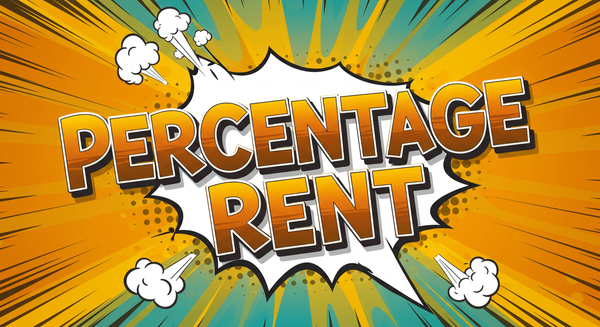The Hidden Truth About "Real" Rental Income: What Effective Rent Actually Means
Whether you're a new landlord trying to compete in today's rental market or an experienced property owner looking to maximize returns, understanding effective rent is essential for survival

Here's a shocking fact that'll change how you think about rental income: Properties using precise effective rent calculations often discover they can enhance their lease income by up to 10% through accurate measurement and strategic concession management. That's because most property owners focus only on the monthly rent number while completely ignoring the true financial impact of incentives and concessions.
Whether you're a new landlord trying to compete in today's rental market or an experienced property owner looking to maximize returns, understanding effective rent isn't optional anymore—it's essential for survival.
Jump To: Frequently Asked Questions About Effective Rent
"Real" Rental Income vs Gross Rental Income
What Is Effective Rent?
Effective rent is the actual money you'll receive from a tenant after accounting for all the freebies, discounts, and incentives you offer to get them to sign a lease. According to the Institute of Real Estate Management (IREM), effective rent serves as "a widely used analysis tool incorporating discounted cash flow and the time value of money to determine the financial impact lease terms and concessions have on property income and value."
It's different from the face rent (the number you advertise) and gross rent (total rent without concessions). The University of Texas at San Antonio's business faculty explains that effective rent is "typically less than quoted rent in a soft market due to concessions such as free rent."
Think of it like buying a car. The sticker price might say $30,000, but after rebates, trade-ins, and financing deals, you might only pay $26,000. That $26,000 is your "effective price"—and the same concept applies to rental properties.
Why This Matters More Than Ever
Today's rental market is incredibly competitive. Tenants expect concessions, landlords offer incentives to fill vacancies quickly, and property managers need to understand the real financial impact of these decisions. Without effective rent calculations, you're basically flying blind with your rental property investments.
HUD's Fair Market Rent determinations rely heavily on effective rent data. Federal housing programs use these calculations to establish payment standards typically set at 90 to 110 percent of Fair Market Rent. This creates direct financial implications for property managers participating in government housing programs.
The relationship between effective rent and other financial metrics like Gross Rent Multiplier (GRM) becomes crucial for making smart investment decisions and properly valuing your rental properties.
Quick Reference Guide
Your most common effective rent questions answered
Types of Rent: Understanding the Full Spectrum
Face Rent vs. Gross Rent vs. Net Effective Rent
Before diving into calculations, let's clarify the different types of rent you'll encounter:
Face Rent (Contract Rent): The monthly amount written in your lease agreement—this is what you advertise and what tenants see in rental listings.
Gross Rent: The total rent amount over the entire lease term without any adjustments for concessions.
Net Effective Rent: The real money you'll receive after subtracting all concessions, free rent periods, and incentives.
Market Rent: What similar properties in your area are actually renting for (their effective rent, not their advertised rent).
How Different Property Types Handle Effective Rent
Residential Properties: Usually involve simpler concessions like one month free rent, reduced security deposits, or included utilities.
Commercial Real Estate: Features more complex arrangements including tenant improvement allowances, rent abatement periods during construction, and leasing commission expenses.
Multi-Family Properties: Often use tiered concession strategies where different units might have different incentive packages based on demand and timing.
The Psychology Behind Rent Concessions
Why Landlords Offer Concessions Instead of Lower Rent
There's actually smart psychology behind offering concessions rather than simply reducing the base rent:
- Market Positioning: A $2,000/month apartment with one month free sounds more prestigious than a $1,833/month apartment
- Lease Renewal Strategy: When renewal time comes, you can eliminate concessions and return to full rent
- Competitive Advantage: Concessions let you compete without permanently devaluing your property
- Tenant Perception: Renters feel like they're getting a "deal" rather than settling for cheaper housing
Common Concession Types and Their Psychological Impact
- Free Rent Periods: Creates urgency and makes tenants feel like winners
- Tenant Improvement Allowances: Gives renters control and personalization options
- Utility Inclusions: Simplifies budgeting and feels like added value
- Move-in Specials: Reduces upfront costs, which is often the biggest barrier for potential tenants
Concession Impact Calculator
See how different incentives affect your effective rent
1 Month Free
8.3%Effective rent: $1,833/month
(from $2,000 face rent)
2 Months Free
8.3%Effective rent: $1,833/month
(from $2,000 face rent)
$5,000 TI Allowance
20.8%Effective rent: $1,792/month
(from $2,000 face rent)
Utility Inclusions
7.5%Effective rent: $1,850/month
(from $2,000 face rent)
The Math Behind Effective Rent: From Simple to Advanced
Basic Effective Rent Calculator Method
The fundamental net effective rent calculation follows this straightforward approach:
- Calculate total gross rent over the entire lease term
- Subtract all concessions (free rent, improvements, etc.)
- Divide by the number of months in the lease term
Real-World Example: A prospective tenant signs a 12-month lease with a base rent of $2,000 per month, but you offer two months free rent:
- Total gross rent: $2,000 × 12 = $24,000
- Less free rent: $2,000 × 2 = $4,000
- Net rent collected: $24,000 - $4,000 = $20,000
- Net effective rent per month: $20,000 ÷ 12 = $1,667
This means your actual monthly rental income is $1,667, not $2,000.
Advanced Present Value Calculations
For longer leases or complex commercial arrangements, you need to account for the time value of money. Money received today is worth more than money received next year. Sophisticated landlords use present value calculations for this reason.
Academic research from the University of Texas at San Antonio demonstrates this principle. For a five-year lease with varying annual rents ($12, $14, and $15 per square foot), the effective rent equals $13.55 per square foot when calculated using a 12% discount rate. The calculation standardization follows established mathematical procedures: Step 1 involves computing the present value of all lease payments, Step 2 converts this present value to an equal annual equivalent using appropriate discount rates.
MIT's real estate finance materials demonstrate that two years of free rent upfront in a six-year lease produces different effective rent calculations than distributed concessions. Property managers commonly seek clarification regarding discount rate selection, with academic sources demonstrating various rates including 7% for secured loans and 8% for unsecured loans.
This becomes especially important when comparing lease options with different concession timing. For instance, offering $4,000 upfront for tenant improvements has a different financial impact than spreading that same $4,000 across monthly rent reductions.
Properties with complex financial structures often benefit from tools like a Net Rental Yield Calculator to understand true investment returns after all concessions and expenses.
Commercial Real Estate Complexity
Commercial properties involve additional factors that residential landlords rarely encounter:
Triple Net Lease Considerations: When tenants pay property taxes, insurance, and maintenance separately, effective rent calculations must account for these additional revenue streams.
Tenant Improvement Allowances: A $50 per square foot improvement allowance on a 2,000 square foot space represents a $100,000 concession that dramatically impacts effective rent.
Leasing Commission Expenses: Broker fees of 4-6% of total lease value must be factored into long-term profitability calculations.
Rent Escalation Clauses: Planned rent increases over time affect the present value of future rental income.
How Effective Rent Impacts Investment Analysis
Integration with Property Valuation Methods
Understanding effective rent becomes crucial when you're evaluating investment properties or determining your property's current value. Just like using a Cap Rate Calculator to assess investment potential, effective rent calculations provide the accurate income data needed for proper valuation.
Many property appraisals fail because they use face rent instead of effective rent, leading to inflated property values and poor investment decisions.
Connection to Capitalization Rates
Your property's cap rate calculation depends heavily on accurate net operating income figures. If you're using face rent instead of effective rent, your cap rate analysis will be fundamentally flawed. This connects directly to Capitalization Rate Analysis methods used throughout the real estate industry.
Cash Flow Planning and Budgeting
Effective rent calculations are essential for:
- Mortgage Qualification: Lenders want to see realistic rental income projections
- Tax Planning: Deductions and depreciation should be based on actual income
- Investment Comparisons: Comparing properties requires apples-to-apples effective rent data
- Portfolio Management: Understanding which properties actually generate the best returns
Regional Variations: How Location Affects Effective Rent Strategy
California's Competitive Rental Market
California's expensive housing market has created sophisticated concession strategies. In cities like San Francisco and Los Angeles, landlords commonly offer:
- Multiple months of free rent to compete with new construction
- Paid parking spaces as concessions
- Pet fee waivers in pet-friendly buildings
- Utility allowances to offset high California energy costs
However, California's rent control laws in many cities affect how concessions can be structured and how rent increases must be calculated based on effective rent rather than face rent.
Texas: Flexibility and Growth Markets
Texas offers more regulatory flexibility, allowing creative lease structures. Common Texas strategies include:
- Graduated rent increases over multi-year leases
- Tenant improvement allowances for customization
- Seasonal concessions in college towns
- Corporate housing packages with furnished options
The lack of state income tax in Texas also affects how landlords structure concessions for tax optimization purposes.
New York's Complex Regulatory Environment
New York presents unique challenges with rent stabilization laws, preferential rent regulations, and complex tenant protection measures. Effective rent calculations become critical for:
- Determining legal rent increase amounts
- Managing preferential rent situations
- Complying with luxury decontrol thresholds
- Handling major capital improvement cost recovery
Florida's Seasonal Market Dynamics
Florida's seasonal rental markets create unique effective rent challenges:
- Winter season premiums vs. summer concessions
- Tourist area short-term vs. long-term rental competition
- Hurricane season impact on lease timing
- Snowbird tenant concession expectations
Other State Considerations
- Washington: Seattle's rapid growth has created intense competition requiring strategic concession timing
- Colorado: Denver's tech boom has led to innovative concession packages targeting young professionals
- Arizona: Phoenix's retiree population influences concession types and lease term preferences
Technology and Tools for Effective Rent Management
Property Management Software Evolution
Modern property management platforms have revolutionized how landlords calculate and track effective rent:
- Automated Calculations: Software now automatically computes effective rent across different concession scenarios
- Market Comparison Tools: Real-time data showing effective rent rates for comparable properties
- Lease Optimization: AI-powered recommendations for optimal concession strategies
- Financial Reporting: Integrated reporting that shows both face rent and effective rent metrics
Free and Affordable Options
Several accessible tools help landlords manage effective rent calculations:
- Spreadsheet Templates: Basic Excel or Google Sheets templates for simple calculations
- Online Calculators: Web-based tools for quick effective rent estimates
- Mobile Apps: Smartphone applications for on-the-go calculations during property showings
- Property Management Platforms: Comprehensive solutions that include effective rent as part of broader property management functionality
Integration Benefits
Advanced property management systems integrate effective rent calculations with:
- Rental Listing Platforms: Automatically adjusting advertised rents based on current concession strategies
- Accounting Software: Ensuring accurate financial reporting and tax preparation
- Market Analysis Tools: Comparing your effective rents against local market data
- Tenant Communication Systems: Clearly explaining lease terms and total costs to potential renters
Strategic Implementation: Building Your Effective Rent System
Developing Concession Guidelines
Successful property managers establish clear policies defining:
When to Offer Concessions:
- High vacancy periods (typically over 5% vacancy rate)
- Slow leasing seasons in your market
- Competition from new construction or major renovations nearby
- Economic downturns affecting tenant demand
Types of Concessions to Consider:
- Free rent periods (most common and easily understood)
- Tenant improvement allowances (particularly for commercial or longer-term leases)
- Reduced security deposits or application fees
- Included services (utilities, parking, storage)
- Pet fee waivers or reduced pet deposits
Maximum Concession Limits:
- Residential: Generally 1-2 months free rent maximum
- Commercial: Up to 10-15% of total lease value in tenant improvements
- Market-dependent: Higher concessions acceptable in extremely competitive markets
Market Research and Competitive Analysis
Understanding your local rental market requires ongoing research:
Competitor Monitoring: Regularly review rental listings to understand what concessions other landlords offer and their effective rent rates.
Seasonal Pattern Recognition: Track how concession patterns change throughout the year in your market.
Economic Indicator Awareness: Monitor local employment rates, new construction starts, and population growth trends that affect rental demand.
Tenant Feedback Collection: Survey current and prospective tenants about their concession preferences and decision-making factors.
Performance Tracking and Optimization
Monitor key metrics to optimize your effective rent strategy:
Financial Metrics:
- Average effective rent across your portfolio
- Concession costs as percentage of gross rent
- Vacancy rates and average time to lease
- Tenant retention rates and lease renewal success
Operational Metrics:
- Application-to-lease conversion rates
- Showing-to-application conversion rates
- Average length of stay for tenants receiving different concession types
- Cost per acquisition for new tenants
Property Management Best Practices
Your essential checklist for effective rent management
Case Studies: Real-World Effective Rent Success Stories
Case Study 1: Urban Apartment Complex Turnaround
The Situation: A 75-unit apartment building in Denver faced 25% vacancy during a local economic downturn.
Previous Strategy: Reducing face rent across all units, which damaged long-term market positioning.
New Effective Rent Approach:
- Offered 6 weeks free rent on 12-month leases
- Provided $500 moving allowances for immediate occupancy
- Maintained higher face rent for market perception
- Created tiered concessions based on lease length
Results:
- Reduced vacancy to 8% within four months
- Maintained face rent 15% higher than previous strategy
- Generated 12% more annual rental income
- Improved lease renewal rates due to higher perceived value
Key Insight: Strategic concessions preserved long-term rental rate integrity while solving immediate occupancy challenges.
Case Study 2: Commercial Office Space Optimization
The Challenge: A 10,000 square foot office building in Austin couldn't compete with newer construction offering modern amenities.
Effective Rent Strategy:
- Offered substantial tenant improvement allowances ($25 per square foot)
- Provided 3 months free rent during improvement period
- Included utilities and parking in lease terms
- Created flexible lease terms allowing for future expansion
Financial Impact:
- Achieved 95% occupancy within 6 months
- Effective rent of $18 per square foot vs. market face rent of $22
- Long-term leases (3-5 years) provided stability
- Tenant improvements increased property value for future sales
Case Study 3: Single-Family Rental Portfolio
The Scenario: An investor owned 15 single-family homes across suburban markets with inconsistent performance.
Systematic Approach:
- Implemented standardized effective rent calculations across all properties
- Developed market-specific concession guidelines
- Used technology to track and compare performance
- Created seasonal adjustment strategies
Portfolio Results:
- Increased average effective rent by 8% across portfolio
- Reduced average vacancy time from 45 days to 28 days
- Improved tenant quality through strategic concession targeting
- Enhanced overall portfolio value through consistent performance
Advanced Effective Rent Strategies
Lease Term Optimization
Different lease terms require different concession strategies:
Short-Term Leases (6-12 months):
- Smaller concessions but higher monthly rates
- Focus on move-in cost reductions
- Emphasize flexibility value to tenants
Medium-Term Leases (12-24 months):
- Balanced concession packages
- Graduated rent increases over term
- Renewal incentives built into initial lease
Long-Term Leases (24+ months):
- Larger upfront concessions acceptable
- Present value calculations become critical
- Focus on total relationship value
Tenant Segmentation Strategies
Different tenant types respond to different concession approaches:
- Young Professionals: Value move-in cost reductions and modern amenities
- Families: Prefer stability and longer-term value propositions
- Retirees: Often prioritize service inclusions and convenience
- Corporate Tenants: Focus on flexibility and professional presentation
Seasonal and Market Timing
Effective rent strategies should adapt to market conditions:
- Peak Leasing Seasons: Reduce or eliminate concessions when demand is high
- Slow Periods: Increase concessions strategically to maintain occupancy
- Market Transitions: Adjust concession types based on changing tenant preferences
- Economic Cycles: Develop different strategies for growth vs. recession periods
Common Pitfalls and How to Avoid Them
Mistake 1: Focusing Only on Monthly Numbers
Many landlords get excited about high monthly rent figures without considering the impact of concessions. This leads to:
- Unrealistic income projections
- Poor cash flow planning
- Incorrect property valuations
- Ineffective competitive positioning
Solution: Always calculate effective rent before making leasing decisions and use it for all financial planning purposes.
Mistake 2: Inconsistent Concession Policies
Without clear guidelines, property managers may:
- Create fairness issues between tenants
- Offer unnecessary concessions during strong markets
- Fail to optimize concession timing
- Generate compliance problems
Solution: Develop written concession policies with clear triggers and approval processes.
Mistake 3: Ignoring Market Research
Failing to understand local market conditions results in:
- Offering concessions when unnecessary
- Missing opportunities to increase effective rent
- Poor competitive positioning
- Tenant acquisition cost inefficiencies
Solution: Regularly research competitor offerings and market conditions to optimize your concession strategy.
Mistake 4: Poor Documentation and Tracking
Inadequate record-keeping creates problems with:
- Tax reporting and deductions
- Property valuation assessments
- Performance analysis and optimization
- Legal compliance and dispute resolution
Solution: Implement systematic documentation procedures for all concessions and their financial impact.
The Future of Effective Rent in Property Management
Technology Integration Trends
Emerging technologies are transforming effective rent management:
Artificial Intelligence: AI-powered systems can analyze market data and recommend optimal concession strategies in real-time.
Dynamic Pricing: Similar to airline and hotel industries, rental properties increasingly use dynamic pricing that automatically adjusts concessions based on demand.
Predictive Analytics: Advanced analytics help predict which concession types will be most effective for specific tenant profiles and market conditions.
Blockchain Integration: Smart contracts could automate concession calculations and ensure transparent, accurate effective rent reporting.
Regulatory Evolution
As rental markets mature, expect increased regulation around:
Disclosure Requirements: More jurisdictions may require advertising effective rent alongside face rent to improve transparency.
Consumer Protection: Enhanced regulations protecting tenants from misleading rental advertisements and concession practices.
Fair Housing Compliance: Stricter oversight of how concessions are offered to ensure equal treatment across protected classes.
Tax Implications: Potential changes to how rental concessions are treated for tax purposes, affecting optimal concession strategies.
Market Adaptation Strategies
Forward-thinking property managers are preparing for:
Increased Tenant Sophistication: Renters increasingly understand effective rent concepts and demand transparency in lease negotiations.
ESG Considerations: Environmental, social, and governance factors influencing concession types, such as energy efficiency improvements or community benefit programs.
Remote Work Impact: Changing space needs affecting commercial effective rent strategies as businesses adapt to hybrid work models.
Generational Preferences: Different concession types appealing to millennial vs. Gen Z renters as market demographics shift.
Building Your Effective Rent Mastery
Implementation Roadmap
Phase 1: Foundation Building (Month 1)
- Calculate current effective rent for all existing leases
- Research local market effective rent rates
- Establish baseline performance metrics
Phase 2: Strategy Development (Month 2)
- Develop concession guidelines and policies
- Implement tracking and documentation systems
- Train staff on effective rent concepts and calculations
Phase 3: Optimization (Months 3-6)
- Test different concession strategies
- Monitor performance and adjust approaches
- Refine policies based on results and market feedback
Phase 4: Advanced Implementation (Months 6+)
- Integrate technology solutions for automation
- Develop sophisticated market analysis capabilities
- Create predictive models for optimal concession timing
Success Metrics to Track
Monitor these key indicators to measure your effective rent strategy success:
Financial Performance:
- Average effective rent trends across your portfolio
- Vacancy rate improvements
- Tenant acquisition cost reductions
- Overall rental income growth
Operational Efficiency:
- Time to lease improvements
- Application-to-lease conversion rate increases
- Lease renewal rate improvements
- Administrative efficiency gains
Market Position:
- Competitive positioning vs. similar properties
- Tenant satisfaction scores
- Market share growth in your target segments
- Brand reputation enhancement
Maximizing Your Property's Potential Through Strategic Effective Rent Management
Understanding and implementing effective rent strategies transforms you from a reactive landlord into a proactive property investment professional. The difference between face rent and effective rent often determines the success of your rental property investments.
By mastering these calculations, implementing strategic concession policies, and maintaining market awareness, you'll make better leasing decisions, improve tenant satisfaction, and maximize your property's financial performance.
The key is recognizing that effective rent isn't just about math—it's about understanding your rental market, anticipating tenant needs, and positioning your property for both short-term occupancy and long-term value appreciation.
Ready to optimize your rental income? Start by calculating the effective rent on all your current leases, research your local market conditions, and develop a strategic approach to concessions that balances competitiveness with profitability. Your investment portfolio—and your bottom line—will benefit significantly from this more sophisticated approach to rental property management.
Remember: in today's competitive rental market, landlords who understand effective rent have a significant advantage over those who focus only on face rent. Make sure you're in the winning group.
Frequently Asked Questions About Effective Rent
What are the differences between net effective rent and gross rent?
Gross rent is the total amount of rent collected over the entire lease term without any adjustments. If you have a 12-month lease at $2,000 per month, your gross rent is $24,000.
Net effective rent takes that gross rent and subtracts all concessions, free rent periods, and incentives you offered. Using the same example, if you gave two months free rent, your net effective rent becomes $20,000 ($24,000 - $4,000 in free rent).
Think of gross rent as your "wishful thinking" number and net effective rent as your "reality check" number.
What is net effective rent and how to calculate it?
Net effective rent is the actual money you'll receive from a tenant after accounting for all concessions and incentives. Here's the simple calculation:
- Calculate total gross rent: Monthly rent × lease length in months
- Add up all concessions: Free rent, tenant improvements, move-in credits, etc.
- Subtract concessions from gross rent: This gives you total net rent collected
- Divide by lease length: This gives you your monthly net effective rent
Example: $1,800/month lease with 1 month free on a 12-month term:
- Gross rent: $1,800 × 12 = $21,600
- Concessions: $1,800 × 1 = $1,800
- Net rent collected: $21,600 - $1,800 = $19,800
- Net effective rent: $19,800 ÷ 12 = $1,650/month
How is effective rent calculated for a property?
The basic formula works for any property type, but the complexity depends on your concessions:
For Simple Residential Leases:
(Total Lease Value - All Concessions) ÷ Number of Months = Monthly Effective Rent
For Complex Commercial Leases:
You'll need to factor in present value calculations, tenant improvement allowances, leasing commissions, and rent escalations over time.
Most property management software can handle these calculations automatically once you input the lease terms and concession details.
What is the difference between market rent and effective rent?
Market rent is what similar properties in your area are actually renting for (their effective rent, not their advertised rent).
Effective rent is what your specific property generates after concessions.
Market rent helps you understand competitive positioning. If market effective rent in your area is $1,500 and your effective rent is $1,650, you're performing above market. If it's $1,400, you might need to adjust your strategy.
What are some practical implications of effective rent in real estate?
Effective rent impacts nearly every aspect of property management:
Investment Analysis: Your property's cap rate and return calculations should use effective rent, not face rent, for accuracy.
Loan Qualification: Lenders want to see realistic rental income projections based on effective rent.
Tax Planning: Deductions and depreciation should reflect actual income received.
Competitive Positioning: Understanding your effective rent vs. market effective rent helps with pricing strategy.
Cash Flow Planning: Budgets and financial projections need effective rent numbers to be realistic.
How do concessions affect net effective rent?
Every concession directly reduces your net effective rent. Here's how different types impact your bottom line:
Free Rent: Reduces effective rent proportionally (1 month free on 12-month lease = 8.3% reduction)
Tenant Improvements: Upfront costs that must be amortized over the lease term
Utility Inclusions: Monthly ongoing costs that reduce net income
Reduced Deposits: Less upfront cash but doesn't affect monthly effective rent
Move-in Credits: One-time reductions that get spread across the lease term
What happens to a discounted rent when the lease is up?
This depends on your lease renewal strategy:
Option 1: Return to Market Rate: Eliminate the discount and charge full market rent for renewal
Option 2: Graduated Increases: Slowly increase rent over time to reach market levels
Option 3: Negotiate New Concessions: Offer different incentives while maintaining higher base rent
Option 4: Extend Discount: Continue discounted rent to retain good tenants (if market conditions warrant it)
Most landlords prefer Option 1 or 2 to avoid permanently devaluing their property.
How does lease length impact net effective rent?
Longer leases generally allow for larger concessions while maintaining attractive effective rent:
12-Month Leases: Limited concession options, typically 1-2 months free rent maximum
24-Month Leases: More flexibility for substantial concessions while spreading costs over longer terms
Commercial Long-Term Leases: Allow for significant tenant improvement allowances and extended free rent periods
The key is that longer leases provide more months to amortize concession costs, making them less impactful on effective rent calculations.
How does effective rent benefit property owners?
Understanding effective rent helps property owners:
Make Better Decisions: Compare lease proposals accurately instead of just looking at monthly rent
Improve Marketing: Offer competitive packages while maintaining profitability
Plan Cash Flow: Forecast actual income instead of optimistic projections
Evaluate Performance: Understand which properties and strategies actually generate the best returns
Competitive Analysis: See how your properties really stack up against market alternatives
How does cap rate relate to effective rent?
Cap rate calculations depend on accurate net operating income figures. If you use face rent instead of effective rent, your cap rate analysis will be wrong.
Correct Cap Rate Formula: (Net Operating Income based on Effective Rent) ÷ Property Value
Using inflated rent figures leads to inflated cap rates, which can result in poor investment decisions and overpaying for properties.
How does effective rent impact lease negotiations?
Effective rent gives both landlords and tenants a framework for honest negotiations:
For Landlords: You can offer various concession packages that achieve the same effective rent while appealing to different tenant preferences.
For Tenants: You can compare different properties and lease structures on an apples-to-apples basis.
Win-Win Scenarios: Creative concession structures can meet tenant needs while maintaining landlord profitability.
Why is calculating net effective rent important?
Net effective rent calculation is crucial for:
Accurate Financial Planning: Budgets and projections based on realistic income expectations
Investment Analysis: Proper evaluation of property performance and investment returns
Competitive Positioning: Understanding your true market position vs. competitors
Regulatory Compliance: Some jurisdictions require effective rent disclosure in advertising
Tax Optimization: Ensuring deductions and depreciation align with actual income received
Skipping effective rent calculations is like driving without a speedometer—you might think you're doing great, but you really have no idea how you're actually performing.





